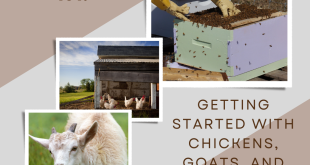Growing Potatoes: Everything You Need to Know
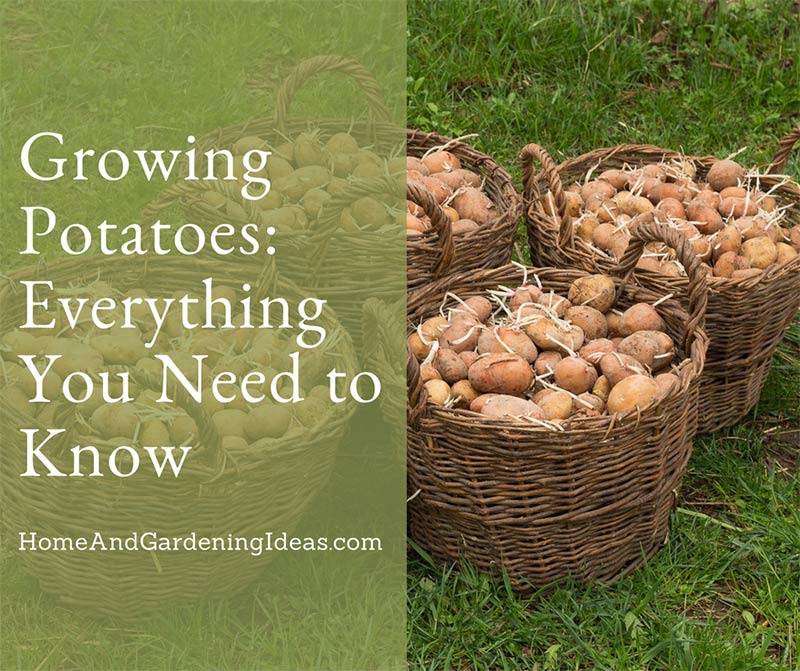
Potatoes seem complicated to grow because you can’t see your progress above ground, but potatoes are easy. Homemade potato chips and herb roasted potatoes could be in your future. All you need to do is learn how to grow potatoes at home.
Requirements to Grow Potatoes
To have the best chance at a plentiful harvest, you have to make sure you understand the requirements to grow potatoes.
- Potatoes need at least six hours of sun per day.
- The soil should be well-draining, light, and high in organic matter. Heavy clay soils make it difficult for tubers to form.
- Unlike other vegetables, potatoes prefer an acidic soil with a pH level between 4.8 to 5.5.
- Select an area where you have not grown potatoes, tomatoes, peppers or eggplants for the past two years. Doing so reduces the risk of soil-borne diseases.
Potato Varieties
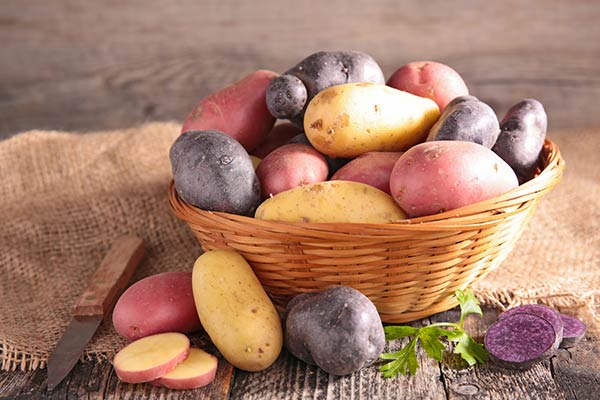
When you purchase your seed potatoes, you will notice a few varieties. Early season potatoes take around 65 days to mature. Midseason potatoes require 80 days to harvest. Late season potatoes take 90 days or longer to reach maturity.
- Irish Cobbler – An early season potato that you can plant quickly in the season.
- Kennebec – Ideal for long-term storage
- French Fingerling – Long, slender, red-skinned potatoes
- All Blue – A fun variety of potatoes that sell well at farmer’s markets.
Planting Potato Plants
To plant potatoes, you need seed potatoes. Official seed potatoes are not the potatoes you purchase in the stores. Using seed potatoes ensures you don’t introduce diseases to your garden. While certain varieties are more popular, such as Yukon Gold, there are over 1,000 different varieties to pick.
Once you have your seed potatoes, it is time to plant them. You can plant them whole or cut into pieces, but each piece has to contain an eye or two. If you cut into pieces, let them callus overnight to prevent diseases.
Potatoes need to be planted in mid to late spring. Warmer climate gardeners should plant in late summer or late winter because potatoes don’t want to grow in the hottest months. Early season varieties can be planted as soon as the soil is workable, which is when the soil temperatures are around 40 degrees Fahrenheit. If you plant mid to late season varieties, plant one to four weeks before your area’s final spring frost.
Each potato plant needs to be one foot apart and planted four to five inches deep. The eye should be pointed upwards when planted. Once your plants start to grow and reach six inches tall, make hills around the roots to protect them. Do so every few weeks as the plant grows.
Trench Method: The traditional method involves digging a shallow trench, around six inches deep, and putting the potatoes into the trench. The eye should face upwards. Then, cover the potatoes with soil. As the potatoes grow, continue to hill up the soil along the sides of the plant. Keep hilling the soil whenever the plant is 4 to 6 inches tall. Once the plant flowers, you can stop hilling.
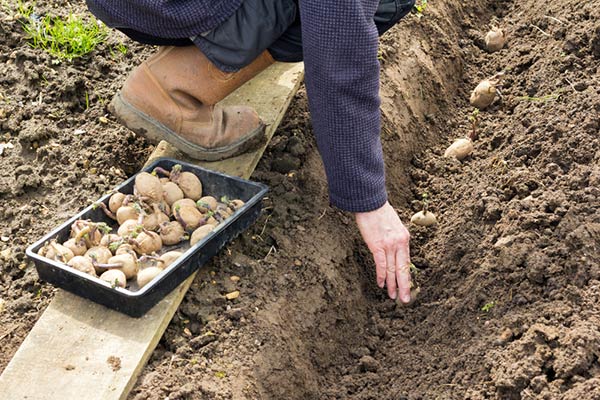
Container Method: Using a container makes hilling easier. Plant your seed potatoes at the bottom of the container. Put six inches at the bottom of the container. As the plant grows, keep adding soil or peat moss. Peat moss is lighter and lowers the pH level.
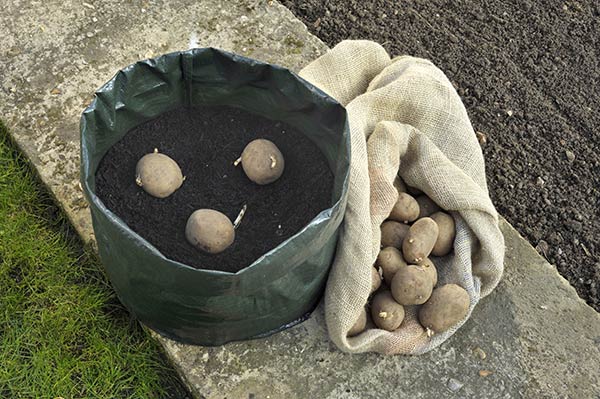

Maintaining Your Potato Plants
If you plant your potatoes in organic matter with the correct pH levels, your plants will grow nicely. Making sure you water the plants regularly is important. Potatoes don’t like dry soil, but they also don’t like standing water. An inch of water each week is ideal. Make sure your soil drains well.
Hilling your potatoes is essential. You want to make sure you often hill so that the tubers stay underground and don’t turn green. Green potatoes are poisonous! Pay attention and add straw, soil or peat moss around the plants every few weeks.
Harvesting Potatoes
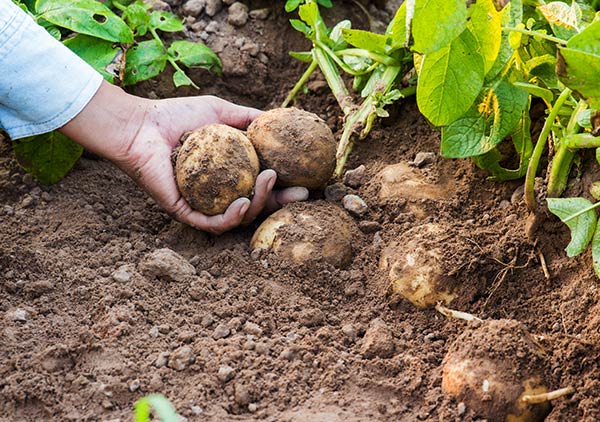
It takes two to four months for your potatoes to be ready for harvest. Once the tops of the plants die, you know the crop is ready for harvest. It is safe to leave the potatoes in the ground for a few weeks afterward, so long as the ground isn’t too wet.
To harvest potatoes, use your hand or shovel to turn over the soil and look for your potatoes. Harvesting potatoes is like searching for hidden treasure! Avoid using a garden fork because you could stab a potato, which means you won’t be able to store it for long.
You can harvest baby potatoes for immediate use. Make sure you use your hands to do this because a shovel or fork can damage the small potatoes.
To store your harvested potatoes, remember never to wash them. Just brush off the potatoes and store them in a dark, cool, well-ventilated area. Most potatoes can last six months if stored in the proper conditions!
Common Pests and Diseases
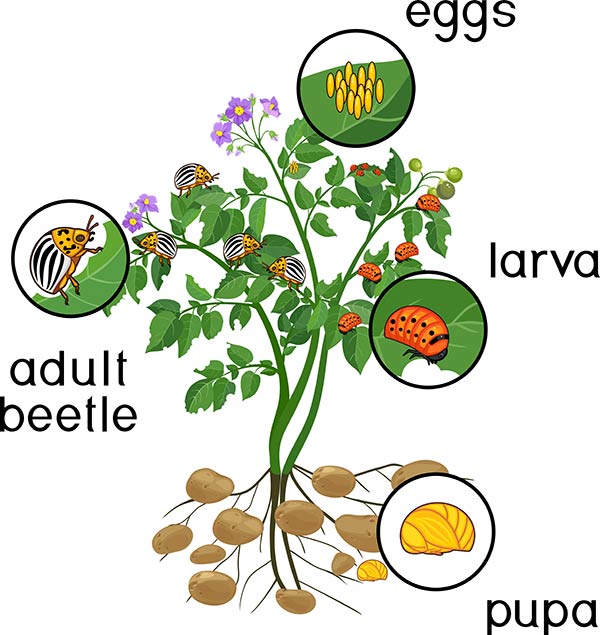
Even though potatoes are easy to grow, there are a few pests or diseases your plants might face.
- Beetles & Aphids: These pests will defoliate your plants. Keep an eye on your plants, checking for evidence of an infestation. Look on the undersides of leaves for eggs and larvae. Most of the time, you can remove these by hand.
- Wire Worms: Wire worms are thin, red worms that attack your plant underground. To avoid these plants, make sure you rotate where you plant your potatoes each year.
- Scab: The most common potato disease is scab, which looks like raised, corky areas on the skin. It also presents itself as sunken holes on the surface. Ensuring the pH level of the soil stays low helps to control scab. Try adding peat moss to the area.
- Late Blight: Late blight is responsible for the Irish potato famine, which causes the foliage to turn black and moldy. Burn or dispose of the foliage. Don’t add it to your compost. You can still harvest the potatoes, but it is best to wait several weeks. To help avoid late blight, use certified disease-resistant seed potatoes.
 Home and Gardening Ideas At home and Gardening ideas we believe inspiring readers about homesteading, self sufficiency
Home and Gardening Ideas At home and Gardening ideas we believe inspiring readers about homesteading, self sufficiency

